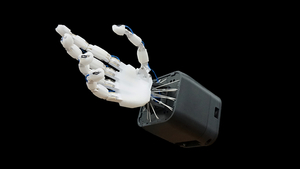

|
Edward Lowton
Editor |


|
| Home> | Plant, Process & Control | >Robotics & Automation | >mimic raises $2.5m and joins the race to develop the first AI-driven robot |
mimic raises $2.5m and joins the race to develop the first AI-driven robot
07 May 2024
mimic develops breakthrough collaborative robots with humanoid hands powered by generative AI to ease severe global labour shortages across industries involving complex, manual tasks.

THE RACE to develop the first commercially available humanoid robot has been primarily concentrated in the US - until now. mimic, a Switzerland-based startup, is challenging US dominance and joining the robotics race to be the first to take a robotic arm and humanoid hand combination to market using generative AI, as it raises a pre-seed round of $2.5m.
mimic’s $2.5m round is led by early stage Swiss investor Founderful, together with participation from German-based fund another.vc, UK-based Tiny.vc and an all-star lineup of specialised angel investors.
Revolutionising how robotics fit into our everyday lives
Spinning out from the research university ETH Zurich, mimic was founded by researchers Elvis Nava, Stefan Weirich,Stephan-Daniel Gravert and Benedek Forrai in 2024. The founding team were working at the intersection of robotics and AI under Professor Robert Katzschmann’s Soft Robotic Labs when they became increasingly convinced that the latest developments in large scale generative AI models would upend a multitude of industries, beyond just language and image generation. The team set out to develop a foundation model for robotic manipulation and quickly realised how much value their idea held to revolutionise the way robotics fit into our everyday lives and economy.
Today, global labour shortages are rocking businesses across multiple sectors and employers are struggling to find, hire and retain workers. Against the backdrop of a pronounced shift in work preferences, like reduced hours and enhanced flexibility to work from home, lab or shortages are especially severe in the case of menial, repetitive, and demanding manual tasks. mimic plans to ease these shortages with dexterous, human-like robotic hands that fit seamlessly into existing manual labour workflows, driven by state-of-the-art AI models trained directly from human demonstrations. “Most use cases are stationary and do not require a full humanoid robot with legs. That’s why we focus data-collection and hardware ingenuity on a universal robotic hand that is compatible with off-the-shelf industrial robotic arms for positioning.” says co-founder Stephan-Daniel Gravert.
A robot designed to mimic a human hand
This solution will enable a robot with humanoid hands to understand and imitate any behavior, simply by watching a human perform it. This marks a departure from conventional robotic solutions, which focus on being purpose-built for narrow use cases. Since each use case requires expensive ad-hoc engineering and comprehensive pre-programmed movements, robots are only able to complete the narrowly specific task they are designed for. In contrast, mimic is developing robots with a unified, general purpose approach to achieve a variety of tasks with a single robot design. “We designed our robot to mimic a human hand so it fits in our world, instead of re-designing the world to fit with our robot,” says co-founder Elvis Nava.
mimic’s robots will be powered by a foundation AI model, meaning they will be able to reason and understand the physical world. The downstream effect is that robots can execute tasks with minimal demonstrations and without requiring expensive, complicated programming by engineers for each new task. These robots are designed for any industry employing workers in repetitive but hard-to-automate tasks involving complex motor skills. Already, the team has been approached by a wide range of initial customers, from supermarkets, industrial baking and gastronomy to manufacturing, recycling and pharmaceutical lab automation.
Taking AI-driven robotic manipulation to the next level
“Conventional automation leaves a huge gap of tedious, low to medium volume manual labour tasks that often fall under the table because they are too complex or not economical to automate. For companies from retail to manufacturing, it becomes increasingly harder to find the right staff for these tasks. Taking AI-driven robotic manipulation to the next level, we can now address these challenges with unparalleled flexibility and ease of use”, says co-founder Stefan Weirich.
Humanoid AI and robotics companies are exploding in popularity. According to Goldman Sachs, the global market for humanoid robots could reach $38bn by 2035. mimic is planning to keep ahead of the competition by collaborating closely with industry clients to develop solutions for the real world while staying laser-focused on platform-agnostic manipulation and hands rather than building an entire humanoid robot.
Alex Stöckl, founding partner at Founderful, commented: "We were impressed by mimic's technology and vision. We believe that the market for AI driven robots is going to grow exponentially, and we will see these robots gain widespread adoption very soon".
Looking forward, the team will spend the coming months further developing their robot and AI model to prepare for mimic’s official product launch this year. “In the robotics space, adopting general-purpose AI techniques can solve a nearly infinite amount of real-world problems. This approach is so far only constrained by the limited availability of robot training data. We are changing that,” adds Nava.
- No related articles listed
- Latest robots: Slim and easy to install
- APP that controls robots
- Collaborative robots: Risks and rewards
- Precision bearings aid smart grasping
- Collaborative robots: Safety matters
- 3D simulation program for robot control
- Bearings chosen for robotic exoskeletons
- Cobot collaboration delivers entry-level vision-guidance
- Robots boost profitability for machining company
- Entry-level vision-guided cobot system



















